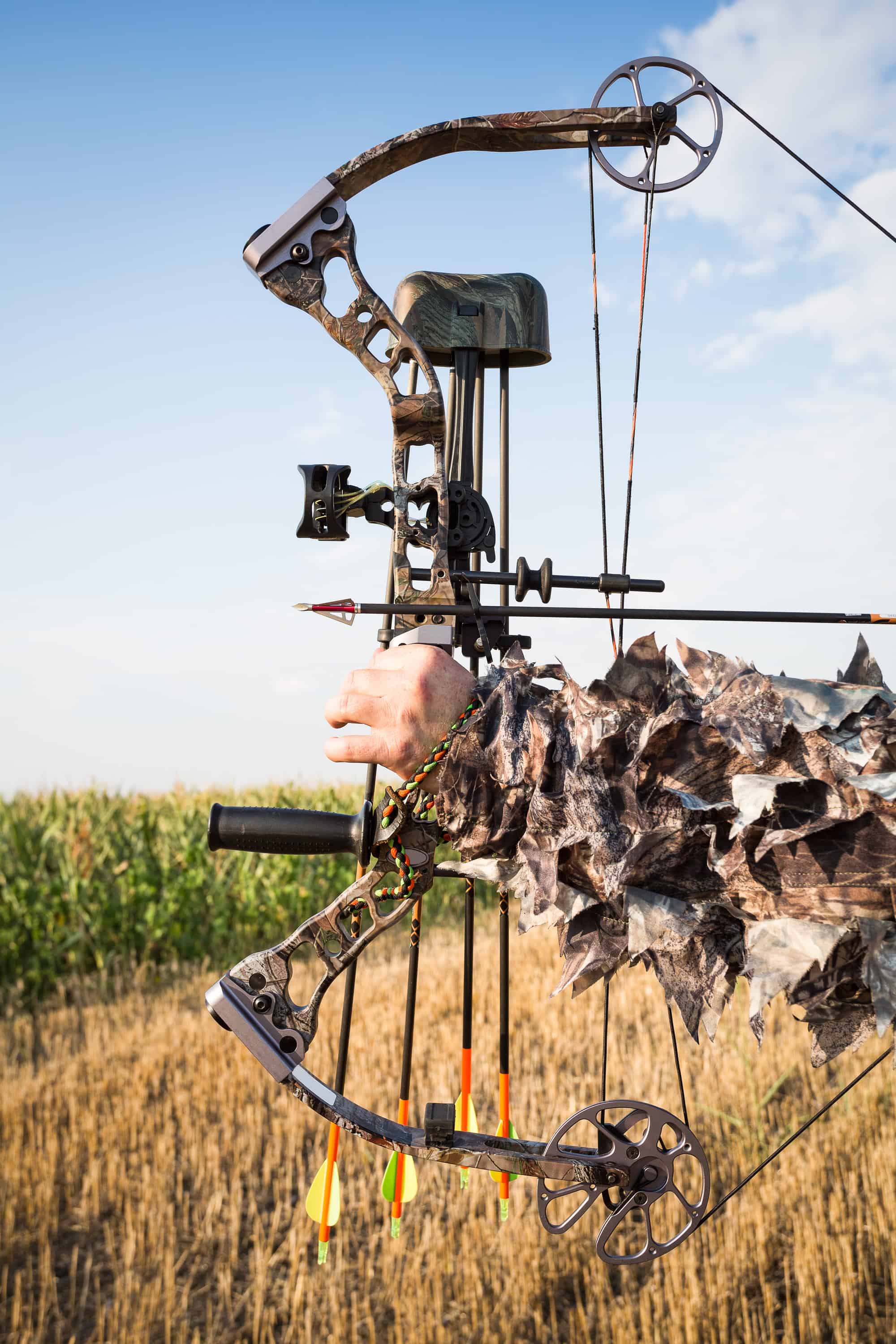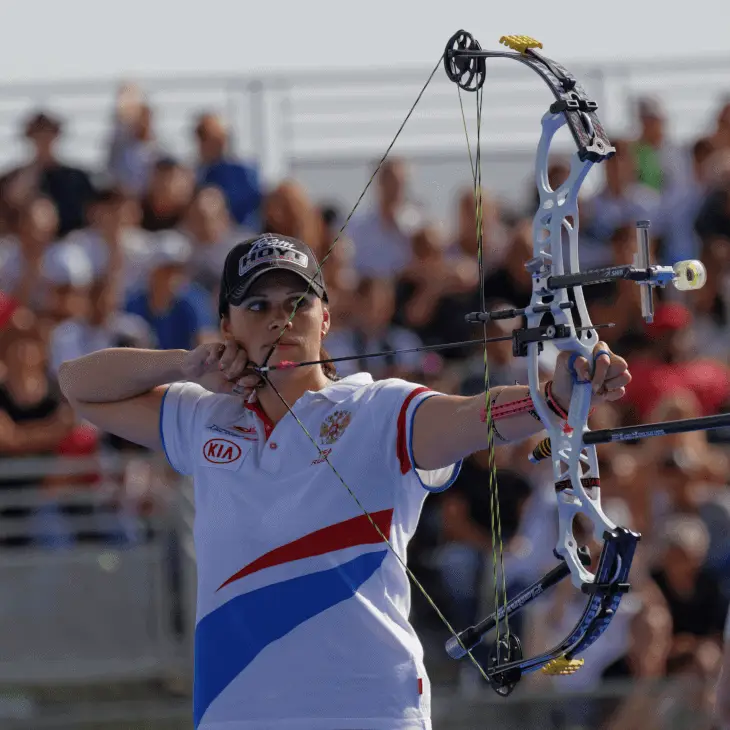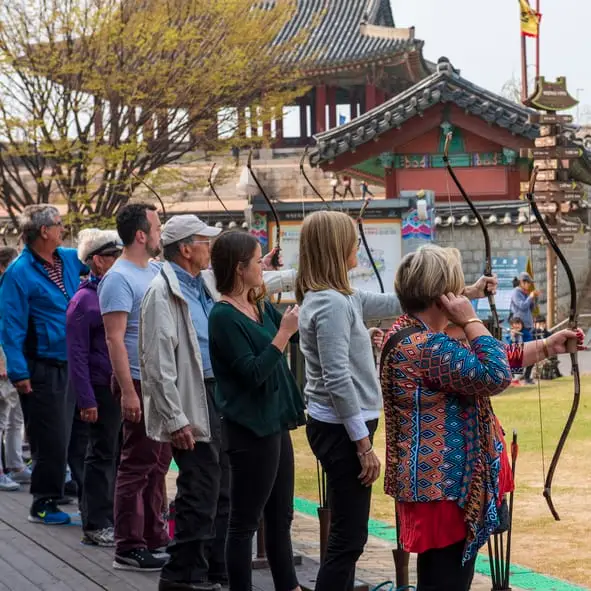
A popular question we get is “how far can a compound bow shoot?” If you want the easy answer, a compound bow firing in a straight line at 400 feet per second can shoot an arrow about 200 feet, around 70 yards. When shot in an arc, this distance can be increased substantially to over 1,000 feet. To understand how we get these numbers, you’ll have to understand a little more about compound bows and the factors that determine arrow speed and distance.
The Evolution of Bows
Bows are weapons with a long history, apparently even used by our primitive ancestors in prehistoric times. Unfortunately, little is known about prehistoric and even ancient bows. Studies of classical texts suggest that the range of ancient bows in the armies of Mediterranean peoples like the Greeks, Assyrians and Carthaginians was anywhere between 64 and 600 meters.
We know more about bows starting in the Medieval Era. The English army created a massive culture surrounding the longbow and used it to much success in the Hundred Years War, encouraging other nations to adopt it as a primary weapon. The English longbow could reach arrow speeds of over 130 FPS and had a maximum range of about 400 yards. Famous archers of the time had record-breaking shots accurate over 300 yards, but the average archer was only accurate up to about 200 yards with the standard practice range being 220 yards. In battle, this effective range was even lower due to fatigue and stress. It’s estimated that only 10% of Medieval archers would have been accurate at a range 200 yards after a week of fighting.
The invention of compound bows in 1966 changed the game. The advanced cam systems increased speed and therefore maximum distance. Even those early compound bows shot well over 200 FPS, usually considered the upper range for modern recurve and longbows. Consequently, they could shoot a lot farther and had a larger effective range than a standard bow’s 10-30 yards. Manufacturers have continued to improve their designs over the decades resulting in a powerful weapon with a considerable maximum distance.
Modern Compound Bows

How far a modern compound bow can shoot is actually a rather complicated calculation and really depends on what exactly you mean. For example, an arrow shot from a hill or tree will have more time to move horizontally before it falls to the ground and will therefore travel a lot farther.
It’s generally accepted that the best compound bows can shoot arrows well over 1,000 feet, but this range usually gets cut short by external factors. Of course, this isn’t taking accuracy into account at all. The record for a compound bow shot hitting a target is 930.04 feet, and the effective range for the average archer is much less, usually pegged between 90 and 180 feet.
Effective Range
The effective range of your compound bow refers to how far away a target, usually a game animal, can be for you to plausibly shoot it in the killzone. The killzone on a whitetail deer is where its heart is and is only about ten inches in diameter. That’s a pretty small target.
As a result, most bowhunters have to be pretty close, around 40 yards, to hit it. Archers who have practiced a lot and honed their accuracy may be able to shoot accurately at up to 60 yards. This usually requires scopes and adjusting for arrow drop. In other words, you can’t just shoot in a straight line. Just like maximum range, this effective range will decrease based on other factors.
Factors Affecting Distance
Arrow Speed
The factor that’s going to make the biggest difference in arrow distance is arrow speed. That’s because the biggest outside force affecting arrow distance is gravity. If you remember your high school physics, gravity on Earth causes objects to accelerate downwards a rate of 9.8 meters per second squared. This results in an easy equation to determine how fall an object will fall as a function of time:
Do the math and you’ll find that your arrow will fall about 5 meters after one second and nearly 20 after two seconds. That’s more than 15 and 60 feet respectively. That means that even if you’re shooting in a straight line from a tree stand, your arrow will fall to the ground in only a couple of seconds.
In other words, arrow speed determines how far the arrow can get before it falls. The majority of compound bows can shoot arrows well over 300 feet per second, and some get close to 400 FPS. You can do the calculation pretty easily yourself. Let’s say you shoot an arrow in a straight line from a tree stand 15 feet off the ground. It’s going to fall to the ground after one second, during which it will have traveled exactly 400 feet, roughly 133 yards.
As you can see, even the fastest arrows don’t get that far when shot in a straight line. For this reason, most archers shoot in an arc to increase the amount of time before they drop. This makes accuracy even harder, though, so you can understand why that effective range for compound bows is so small.
Additionally, arrow speed is not all that consistent. Compound bow manufacturers advertise their bows as having a specific arrow speed, but this is based on a standard set by the IBO (International Bowhunting Organization). That standard uses:
70-pound draw weight (rarely, manufacturers use different draw weights for ratings)
30-inch draw length
An arrow weighing 5 grains per pound of draw weight (ie, 350 grains)
If any of those numbers are different when you’re shooting, the actual arrow speed will be different than what the manufacturer rated it for, and therefore the distance the arrow travels will be different. That could mean not drawing to full length, adjusting the draw weight higher or lower than 70 pounds, or using a heavier or lighter arrow. Luckily, if you know exactly what those numbers are, you can calculate the actual arrow speed from the IBO rating, so let’s take a look at those specs.
Draw Weight
Draw weight is one of the main compound bow specs that can help you determine its arrow speed and therefore maximum distance. Draw weight refers to the amount of force needed to pull back the bowstring. For example, a bow with 60 pounds of draw weight takes the same force to draw as it would to lift a 60-pound dumbbell off the floor. With a compound bow, it might not actually feel that difficult because the cam system provides something called “let-off” that decreases the portion of the draw weight you actually have to pull back. Nevertheless, it has the same amount of energy stored at full draw.
No bow is 100% efficient, but generally speaking, the force you use to pull back the bowstring is the same force that’s applied to the arrow when you release it. As you might guess, a higher draw weight means more power and energy and consequently more speed.
Generally speaking, a five-pound change in draw weight will change your arrow speed by 9 FPS. If your bow is rated for 350 FPS, that’s at 70 pounds of draw weight, so if you’re actually shooting with 60 pounds of draw weight—all else being equal—you’ll subtract 18 FPS from your arrow speed resulting in 332 FPS. Consequently, your arrow won’t travel as far.
Draw Length
Draw length matters because it determines the amount of time the bowstring has to accelerate the arrow. The same bow drawn farther back will apply force to the arrow for a split second more of time, but that’s enough to increase speed significantly.
With compound bows, it’s harder to vary the draw length when you’re shooting. A side effect of the let-off provided by a compound bow’s cam system is a valley of draw weight. In other words, when you draw a compound bow, the tension on the bow string makes it increasingly difficult until you reach a point where it suddenly lets off and gets much easier. When you pull it even farther back, you’ll hit a wall where it’s even more difficult to pull back than it was in the first place. As a result, you can consistently draw to the rated draw length just before the wall.
Still, changing the draw length is possible. In fact, some compound bow models allow you to adjust the cams to change the draw length. Every inch difference will change your arrow speed by 10 FPS. Your bow’s IBO speed rating is based on a draw length of 30 inches, so if it’s rated for 350 FPS but you’re tall and have altered the draw length up to 32 inches, your arrow speed will actually be 370 FPS. Your arrows will travel that much farther as a result.
Arrow Weight
The heavier the arrow, the slower it’s going to go. That’s because a heavier object takes more force and therefore more energy to accelerate. Just take a look at the formula for kinetic energy:
Before you shoot it, your bow stores its kinetic energy in its limbs and bowstring like a spring. When you release the bow, it transfers most of that energy to the arrow. If you work through the formula, you’ll see that when the kinetic energy is the same, an arrow with more mass will necessarily have lower velocity and vice versa.
Arrow weights are listed in grains, an ancient unit of measurement theoretically equal to a single seed of cereal grain. As you might guess then, a single grain is pretty small, roughly 65 milligrams or 1/7,000 of a pound. IBO arrow speed is based on an arrow of 350 grains. As a general rule, a change in weight of three grains will change the arrow speed by one foot per second. Therefore, if your bow is rated for 350 FPS, but you use an arrow of 320 grains, for instance, your arrow speed will decrease by 10 FPS resulting in 340 FPS. That means your arrow won’t shoot quite as far.
You should also know that adding any other weight to your string through accessories will have the same effect. Just remember to convert the weight to grains beforehand.
Calculating Maximum Distance

So after asking “How Far Can a Compound Bow Shoot”, now that you know all the factors affective arrow speed, you can calculate your maximum straight-line distance with a little arithmetic. The equation for determining the time it will take an object to fall a certain distance is:
So for an example, let’s say you’re shooting an arrow in a straight line from about two meters off the ground. That means you’re either really tall or standing on some kind of platform, but 2 is an easy number, so let’s go with it. Plug 2 in for d and 10 for g, and you something close to 0.6 seconds.
Now, how far can your arrow travel in that time? Let’s use our examples from above. Your compound bow is IBO rated for 350 FPS, but you’ve tuned the draw weight down to 60 pounds, the draw length up to 32 inches, and you’re using an arrow that weighs 320 grains. Factor all that in, and your arrow will be moving at 363 feet per second. Multiply that by 0.6 for the amount of time it will actually be in the air, and you get roughly 230 feet. That’s how far your bow should shoot in a straight line.





